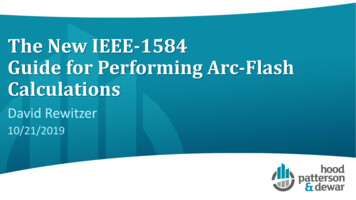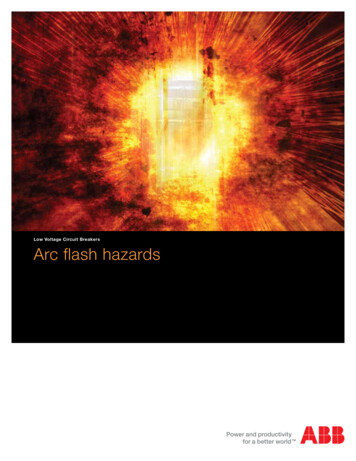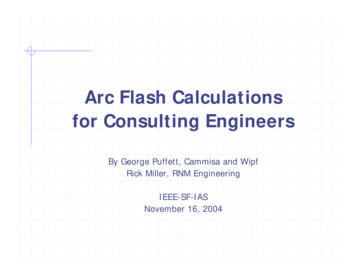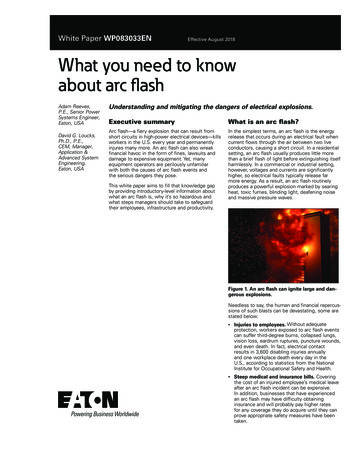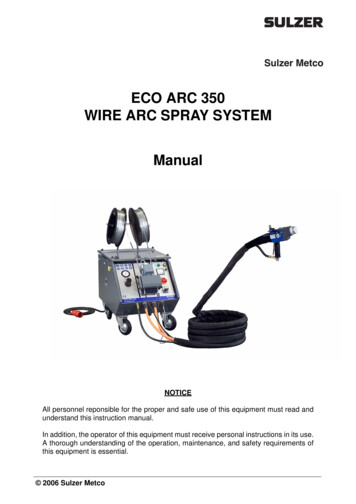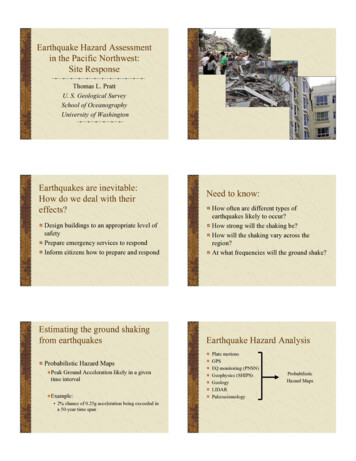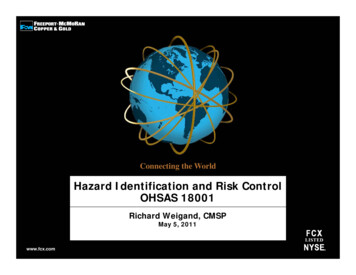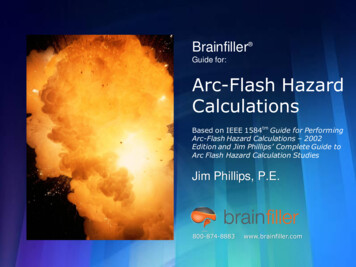
Transcription
Brainfiller Guide for:Arc-Flash HazardCalculationsBased on IEEE 1584tm Guide for PerformingArc-Flash Hazard Calculations – 2002Edition and Jim Phillips’ Complete Guide toArc Flash Hazard Calculation StudiesJim Phillips, P.E.800-874-8883t 2gPage 1www.brainfiller.comwww.brainfiller.com
Your International Source for ElectricalPower TrainingTerms and Conditions / DisclaimerHow to Perform an Arc Flash Calculation StudyArc Flash StudiesBased on IEEE 1584, NFPA 70E, NESC Standards, DC Research and Jim Phillips’ ArcFlash Book and GuideThis guide and worksheets were developed by Brainfiller, Inc. / Jim Phillips, P.E., Scottsdale, AZ and areprovided “as is”. Brainfiller, Inc. / Jim Phillips, P.E., make no warranties or representations of any kind,whether expressed or implied, for the suitability for use of the guide and worksheets which are beingprovided and explicitly disclaim any warranty of merchantability or fitness for any purpose whatsoever.Neither Brainfiller, Inc. or Jim Phillips, P.E. are providing or offering to provide engineering services and willnot be responsible for any damage you suffer as a result of using the worksheets regardless of cause.Calculations should only be conducted under the direction of a qualified Professional Engineer. Theworksheets are developed by Jim Phillips, P.E. and are protected under United States Copyright laws.Permission is granted to reproduce the worksheets in their entirety without modification and providingcredit to Brainfiller, Inc. and Jim Phillips, P.E .The worksheets are derived from equations published in IEEE 1584-2002tm. Using the results of thecalculations from these equations does not insure that a worker will not face injury or death from an arcflash. Following NFPA 70E and IEEE 1584 procedures and wearing the proper protective equipment willgreatly reduce the possibility of injury and death.ALWAYS WORK ON SYSTEMS PLACED IN AN ELECTRICALLY SAFE CONDITION WHEN POSSIBLEPER NFPA 70EBy accepting this guide and worksheets, the user agrees to the terms and conditions listed on this page.t 2gCopyright 2012 Brainfiller, Inc All right reserved Use of this guide is subject to the terms and conditions provided as part of this documentPage 2P.E. call 1-800-874-8883 or visit www.Brainfiller.com Page 2www.brainfiller.comFor information about available training programs by Jim Phillips
Your International Source for ElectricalPower TrainingComplete Guide to Arc Flash Hazard Calculation Studies - 79.00How to Perform an Arc Flash Calculation StudyArc Flash StudiesBased on IEEE 1584, NFPA 70E, NESC Standards, DC Research and Jim Phillips’ ArcFlash Book and GuideThis book takes Arc Flash to the next level by showing you how to perf ormthe complete Arc Flash Hazard Calculation Study (AFHCS) including IEEE1584 calculations, data collection, system modeling and details you need toperf orm the complete study.Using a series of f low charts, examples and calculation worksheets, I breakthe study process down to a detailed step by step approach. Manyimportant and helpf ul f eatures are included in this book such as:Step by Step Approach – This book takes the entire AFCS process andbreaks it down into individual steps with one chapter f or each step.Solved examples – Dozens of solved example problems are provided tohelp illustrate the details of each equation and calculation method.Calculation Work sheets – Solving complex equations such as those usedf or an AFHCS can seem overwhelming. However, I take each arc f lashequation and breaks it down into simple steps laid out on a work sheet thatyou can use f or solving the problems.Order your copy at:www.brainfiller.com800.874.8883t 2gTricks and Traps – Many questions and potential problem areas aref requently encountered when perf orming the AFHCS. I provides many tricksthat can be used f or the study and also warnings about the potential trapsthat could be encountered. You will also see how to successf ully makeassumptions and simplif y the overall process .Copyright 2012 Brainfiller, Inc All right reserved Use of this guide is subject to the terms and conditions provided as part of this documentPage 3P.E.For informationabout available training programs2by JimPhillipscall 1-800-874-8883 Page ainingGroup or visit www.Brainfiller.com800-874-8883TG
Your International Source for ElectricalPower TrainingINDEXArc Flash StudiesHow to Perform an Arc Flash Calculation StudyBased on IEEE 1584, NFPA 70E, NESC Standards, DC Research and Jim Phillips’ ArcFlash Book and GuideTerms and Conditions / Disclaimer1.0Introduction2.0Arcing Short Circuit Current CalculationsDiscussionWorksheetsExample Problem3.0Incident Energy CalculationsDiscussionWorksheetsArc Flash DurationExample Problems4.0Arc Flash Boundary CalculationsDiscussionWorksheetsExample ProblemsReferences5.0Copyright 2012 Brainfiller, Inc All right reserved Use of this guide is subject to the terms and conditions provided as part of this documentFor information about available training programs by Jim Phillips P.E. call 1-800-874-8883 or visit www.Brainfiller.com Page 4
Your International Source for ElectricalPower Training1.0 IntroductionArc Flash StudiesHow to Perform an Arc Flash Calculation StudyBased on IEEE 1584, NFPA 70E, NESC Standards, DC Research and Jim Phillips’ ArcFlash Book and GuideThis Brainfiller Guide for Arc Flash Hazard Calculationscontains a series of worksheets that have been developedbased on equations published in IEEE 1584-2002tm Guidefor Performing Arc-Flash Hazard Calculations and JimPhillips’ book Complete Guide to Arc Flash HazardCalculation Studies. The worksheets are designed to assistin manual arc flash calculations and are not intended as areplacement for the IEEE 1584 or NFPA 70E Standards orany other standards. The user must still comply with therequirements of these standards which contain additionaldetails not shown here. The user should obtain a completecopy of the most current edition of both IEEE 1584 andNFPA 70EFor a better understanding of arcflash calculations, order Jim’s arcflash video series and book atwww.brainfiller.comIt is assumed the user already has an understanding of arcflash calculations and related standards.The guidecontains worksheets for estimating arcing short circuitcurrent, calculating the incident energy and calculating thearc flash boundary.Copyright 2012 Brainfiller, Inc All right reserved Use of this guide is subject to the terms and conditions provided as part of this documentFor information about available training programs by Jim Phillips P.E. call 1-800-874-8883 or visit www.Brainfiller.com Page 5
Your International Source for ElectricalPower Training2.0 Arcing Short Circuit Current Calculations - DiscussionHow to Perform an Arc Flash Calculation StudyArc Flash StudiesBased on IEEE 1584, NFPA 70E, NESC Standards, DC Research and Jim Phillips’ ArcFlash Book and Guide480 VoltsThe first step in conducting arc flashcalculations is to estimate the arcingshort circuit current. The magnitude ofan arcing fault will be less than abolted fault due to the arc impedance.225 A C/BThe calculation is based on using thebolted three phase short circuit currentobtained from a standard short circuitstudy. This value along with othervariables such as arc gap distance isinput into the equation on the nextpage.30,000 AmpsBolted 3 phase faultPanel 1The worksheet in this section providesa step-by-step process for estimatingthe arcing current.XCopyright 2012 Brainfiller, Inc All right reserved Use of this guide is subject to the terms and conditions provided as part of this documentFor informationabout available training programs2by JimPhillips P.E.call 1-800-874-8883 Page 6www.brainfiller.comTechnicalTrainingGroup or visit www.Brainfiller.com800-874-8883TG
Your International Source for ElectricalPower Training2.0 Arcing Short Circuit Current Calculations - DiscussionHow to Perform an Arc Flash Calculation StudyArc Flash StudiesBased on IEEE 1584, NFPA 70E, NESC Standards, DC Research and Jim Phillips’ ArcFlash Book and GuideIEEE 1584-2002tm Equation For Estimating the Arcing Short Circuit Currentlog Ia k 0.662log Ibf 0.0966V 0.000526G 0.5588V(log Ibf ) – 0.00304G (log Ibf )Ia 10 log Ialog log10Ia arcing current in kAk - 0.153 for open air and - 0.097 for arcs in a boxIbf bolted three-phase available short-circuit current (symmetrical rms kA)V system voltage in kVG conductor gap in millimeters (mm)Copyright 2012 Brainfiller, Inc All right reserved Use of this guide is subject to the terms and conditions provided as part of this documentFor informationabout available training programs2by JimPhillips P.E.call 1-800-874-8883 Page 7www.brainfiller.comTechnicalTrainingGroup or visit www.Brainfiller.com800-874-8883TG
Your International Source for ElectricalPower Training2.0 Arcing Short Circuit Current Calculations - DiscussionHow to Perform an Arc Flash Calculation StudyArc Flash StudiesBased on IEEE 1584, NFPA 70E, NESC Standards, DC Research and Jim Phillips’ ArcFlash Book and GuideTable 1 Factors for Equipment and Voltage Classes - From IEEE 1584-2002tmSystemVoltage(kV)TypicalConductorGap (mm)DistanceX-FactorOpen-airSwitchgearMCC’s and panelsCables10 – 403225132.0001.4731.6412.000 1 to 5Open-airSwitchgearCables13 – 102102132.0000.9732.000 5 to 15Open-airSwitchgearCables13 – 153153132.0000.9732.0000.208 to 1Type ofEquipmentCopyright 2012 Brainfiller, Inc All right reserved Use of this guide is subject to the terms and conditions provided as part of this documentFor informationabout available training programs2by JimPhillips P.E.call 1-800-874-8883 Page 8www.brainfiller.comTechnicalTrainingGroup or visit www.Brainfiller.com800-874-8883TG
Your International Source for ElectricalPower Training2.0 Arcing Short Circuit Current Calculations - WorksheetHow to Perform an Arc Flash Calculation StudyArc Flash StudiesBased on IEEE 1584, NFPA 70E, NESC Standards, DC Research and Jim Phillips’ ArcFlash Book and GuideThree Phase Arcing Short Circuit Current Work SheetSystem Voltage 1kVIbf Bolted 3 Phase Short CircuitCurrent in kAV system voltage in kVG Conductor gap (mm)K - 0.153 for open air arcs - 0.097 for arcs in a boxStep 10.662 x log (Ibf )0.662 x Log ()Step 20.0966 x V0.0966 x ()Step 30.000526 x G0.000526 x ()Step 40.5588 x V x log (Ibf )0.5588 x (0.5588 x (Step 5- 0.00304 x G x log (Ibf )-0.00304 x (-0.00304 x () x log ()x() x log ()x(Step 6Add KK - 0.153 for open air arcsK - 0.097 for arcs in a boxStep 7log (Ia) Step 1 Step 2 Step 3 Step 4 Step 5 Step 6Total Iarcing10 log (Ia) for many calculators enter 10 [YX] (Answer from Step 7)))))--Copyright 2012 Brainfiller, Inc All right reserved Use of this guide is subject to the terms and conditions provided as part of this documentFor informationabout available training programs2by JimPhillips P.E.call 1-800-874-8883 Page 9www.brainfiller.comTechnicalTrainingGroup or visit www.Brainfiller.com800-874-8883TGkA
Your International Source for ElectricalPower Training2.0 Arcing Short Circuit Current Calculations – Example ProblemHow to Perform an Arc Flash Calculation StudyArc Flash StudiesBased on IEEE 1584, NFPA 70E, NESC Standards, DC Research and Jim Phillips’ ArcFlash Book and Guide480 VoltsThe following example illustrates howto perform arc flash calculations usingthe worksheets. The one line diagramto the right shows a 480 Volt panelprotected by an upstream 225 Ampcircuit breaker.225 A C/BA short circuit study indicates theavailable “bolted” three-phase faultcurrent at Panel 1 is 30,000 Amps.This example illustrates how toestimate the arcing short circuitcurrent.The power system is considered to besolidly grounded and the arc flash is ina box representative of an enclosure.30,000 AmpsBolted 3 phase faultPanel 1XCopyright 2012 Brainfiller, Inc All right reserved Use of this guide is subject to the terms and conditions provided as part of this documentFor informationabout available training programs2by JimPhillips P.E.call 1-800-874-8883 Page 10www.brainfiller.comTechnicalTrainingGroup or visit www.Brainfiller.com800-874-8883TG
Your International Source for ElectricalPower Training2.0 Arcing Short Circuit Current Calculations – Example ProblemHow to Perform an Arc Flash Calculation StudyArc Flash StudiesBased on IEEE 1584, NFPA 70E, NESC Standards, DC Research and Jim Phillips’ ArcFlash Book and GuideThree Phase Arcing Short Circuit Current Work SheetSystem Voltage 1kVIbf Bolted 3 Phase Short CircuitCurrent in kAV system voltage in kVG Conductor gap (mm)K - 0.153 for open air arcs - 0.097 for arcs in a box30)0.977850.48)0.0463725)0.01315Step 10.662 x log (Ibf )0.662 x Log (Step 20.0966 x V0.0966 x (Step 30.000526 x G0.000526 x (Step 40.5588 x V x log (Ibf )0.5588 x ( 0.48 ) x log ()300.5588 x ( 0.48 ) x (1.47712 )Step 5- 0.00304 x G x log (Ibf )-0.00304 x ( 25 ) x log ()30-0.00304 x ( 25 ) x (1.47712 )Step 6Add KK - 0.153 for open air arcsK - 0.097 for arcs in a boxStep 7log (Ia) Step 1 Step 2 Step 3 Step 4 Step 5 Step 6Total Iarcing10 log (Ia) for many calculators enter 10 [YX] (Answer from Step 7)0.39620-0.11226-0.097001.2243116.761Copyright 2012 Brainfiller, Inc All right reserved Use of this guide is subject to the terms and conditions provided as part of this documentFor informationabout available training programs2by JimPhillips P.E.call 1-800-874-8883 Page 11www.brainfiller.comTechnicalTrainingGroup or visit www.Brainfiller.com800-874-8883TGkA
Your International Source for ElectricalPower Training2.0 Arcing Short Circuit Current Calculations – Example ProblemHow to Perform an Arc Flash Calculation StudyArc Flash StudiesBased on IEEE 1584, NFPA 70E, NESC Standards, DC Research and Jim Phillips’ ArcFlash Book and GuideWorksheet - Estimate Arcing Short Circuit Current:Ste
Based on IEEE 1584, NFPA 70E, NESC Standards, DC Research and Jim Phillips’ Arc Flash Book and Guide www.brainfiller.com T 2 G Technical Training Group 800-874-8883 Complete Guide to Arc Flash Hazard Calculation Studies - 79.00 This book takes Arc Flash to the next level by showing you how to perform the complete Arc Flash Hazard Calculation Study (AFHCS) including IEEE 1584 calculations .
